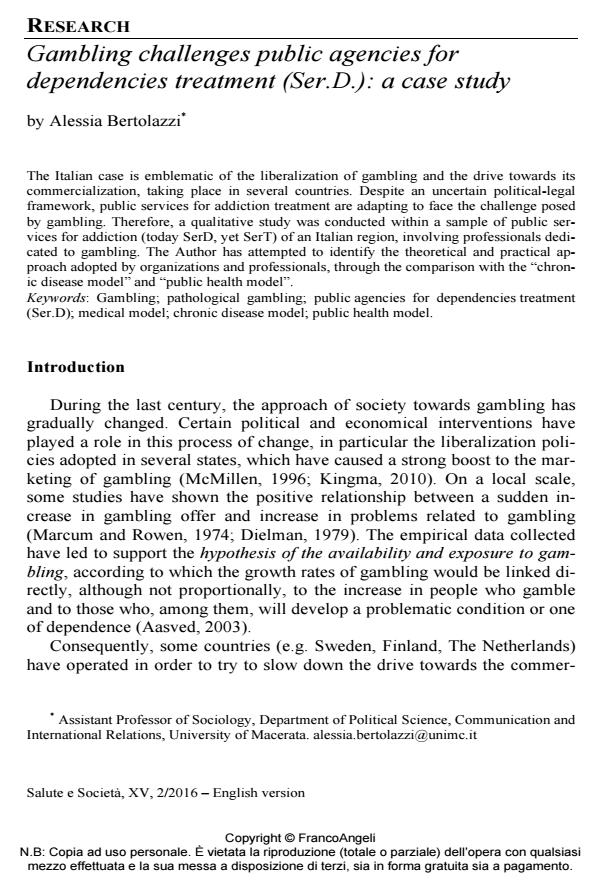Gambling challenges public agencies for dependencies treatment (Ser.D.): a case study
Titolo Rivista SALUTE E SOCIETÀ
Autori/Curatori Alessia Bertolazzi
Anno di pubblicazione 2016 Fascicolo 2016/suppl. 2 Lingua Inglese
Numero pagine 15 P. 97-111 Dimensione file 94 KB
DOI 10.3280/SES2016-SU2008
Il DOI è il codice a barre della proprietà intellettuale: per saperne di più
clicca qui
Qui sotto puoi vedere in anteprima la prima pagina di questo articolo.
Se questo articolo ti interessa, lo puoi acquistare (e scaricare in formato pdf) seguendo le facili indicazioni per acquistare il download credit. Acquista Download Credits per scaricare questo Articolo in formato PDF

FrancoAngeli è membro della Publishers International Linking Association, Inc (PILA)associazione indipendente e non profit per facilitare (attraverso i servizi tecnologici implementati da CrossRef.org) l’accesso degli studiosi ai contenuti digitali nelle pubblicazioni professionali e scientifiche
The Italian case is emblematic of the liberalization of gambling and the drive towards its commercialization, taking place in several countries. Despite an uncertain political-legal framework, public services for addiction treatment are adapting to face the challenge posed by gambling. Therefore, a qualitative study was conducted within a sample of public services for addiction (today SerD, yet SerT) of an Italian region, involving professionals dedicated to gambling. The Author has attempted to identify the theoretical and practical approach adopted by organizations and professionals, through the comparison with the "chronic disease model" and "public health model". l
Keywords:Gambling; pathological gambling; public agencies for dependencies treatment (Ser.D); medical model; chronic disease model; public health mode
- Aasved M.J. (2003). The Sociology of Gambling. Vol. 2, Springfield: Charles C. Thomas Publisher.
- American Psychiatric Association (1980). Diagnostic and Statistical Manual of Mental Disorders, Third Edition (DSM-III). Washington, D.C.: APA.
- American Psychiatric Association (1994). Diagnostic and Statistical Manual of Mental Disorders, Fourth Edition (DSM-IV). Washington, D.C.: APA.
- American Psychiatric Association (2013). Diagnostic and Statistical Manual of Mental Disorders, Fifth Edition (DSM-V). Washington, D.C.: APA.
- Berkman L.F. (1995). The Role of Social Relations in Health Promotion. Psychosomatic Medicine, 57 (3): 245-254. DOI: 10.1097/00006842-199505000-0000
- Bertolazzi A. (2013). Il gioco d’azzardo tra alea e sicurezza. In: Cipolla C., editor, La sicurezza come politica. Milano: FrancoAngeli.
- Bertolazzi A. (2014). Il gioco d’azzardo online: rischi per una pratica sociale a vincoli deboli. In: Cipolla C., editor, Le implicazioni criminologiche e vittimologiche del gioco d’azzardo. Milano: FrancoAngeli.
- Blaszczynski A., Ladouceur R., Shaffer H.J. (2004), A science-based framework for responsible gambling: the Reno model. Journal of Gambling Studies, 20 (3): 301-17. DOI: 10.1023/B:JOGS.0000040281.49444.e
- Castellani B. (2000). Pathological gambling. The making of a medical problem. Albany: State University of New York Press.
- Cisneros Örnberg J. (2006). Nordic gambling markets and the possibilities for state-level control. Journal of Gambling Issues, 18: 9-29. DOI: 10.4309/jgi.2006.18.
- Cisneros Örnberg J., Tammi T. (2011). Gambling problems as a political framing. Safeguarding the monopolies in Finland and Sweden. Journal of Gambling Issues, 26: 110-125. DOI: 10.4309/jgi.2011.26.
- Cosgrave J.F., editor (2006). The Sociology of Risk and Gambling Reader. London: Routledge.
- Dielman T.E. (1979). Gambling: a social problem? Journal of Social Issues, 35: 36-42.
- Ferentzy P., Skinner W. (2003). Gamblers Anonymous: A critical review of the literature. Journal of Gambling Issues, 9. DOI: 10.4309/jgi.2003.9.
- Ferentzy P., Turner N.E. (2012). Morals, medicine, metaphors, and the history of the disease model of problem gambling. Journal of Gambling Issues, 27: 1-27. DOI: 10.4309/jgi.2012.27.
- Furedi F. (2008). Il nuovo conformismo. Troppa psicologia nella vita quotidiana.
- Milano: Feltrinelli. Hodgins D.C., el-Guebaly N. (2000). Natural and treatment-assisted recovery from gambling problems: a comparison of resolved and active gamblers. Addiction, 95 (5): 777-789. DOI: 10.1046/j.1360-0443.2000.95577713.
- Kingma S.F. (2008). The liberalization and (re)regulation of Dutch gambling markets: National consequences of the changing European context. Regulation & Governance, 2: 445-458. DOI: 10.1111/j.1748-5991.2008.00045.
- Kingma S.F., editor (2010). Global gambling: cultural perspectives on gambling organizations. London: Routledge.
- Korn D., Shaffer H. (1999). Gambling and the health of the public: adopting a public health perspective. Journal of Gambling Studies, 15(4): 289-365. DOI: 10.1023/A:102300511593
- Marcum J., Rowen H. (1974). How many games in town? The pros and cons of legalized gambling. Public Interest, 36: 26-52.
- McMillen J. (1996). Understanding Gambling. History, concepts and theory. In: McMillen J., editor, Gambling Cultures. London: Routledge.
- Pavarin R.M., Marani S., Turino E., Limonta N., Sanchini S., Colaninno M. (2012). Stima della prevalenza di soggetti con gioco d’azzardo patologico nell’area metropolitana di Bologna e analisi del sommerso. Italian Journal on Addiction, 2 (3-4): 98-102.
- Peele S. (2001). Is gambling an addiction like drug and alcohol addiction? Developing realistic and useful conceptions of compulsive gambling, Journal of Gambling Issues, 3. DOI: 10.4309/jgi.2001.3.
- Petry N.M., Stinson F.S. e Grant B.F. (2005). Comorbidity of DSM-IV Pathological Gambling and Other Psychiatric Disorders. Journal of Clinical Psychiatry, 66 (5): 564-574. DOI: 10.4088/JCP.v66n050
- Room R. (2005). The wheel of fortune: Cycles and reactions in gambling policies. Addiction, 100: 1226-1227. DOI: 10.1111/j.1360-0443.2005.01201.
- Rosecrance J. (1985). Compulsive gambling and the medicalization of deviance. Social Problems, 32: 275-284. DOI: 10.1525/sp.1985.32.3.03a0009
- Rosecrance J. (1989). Controlled gambling: A promising future. In: H.J. Shaffer, S.A. Stein, B. Gambino, T.N. Cummings, eds., Compulsive gambling, theory, research and practice. Lexington, MA: Lexington Books.
- Shaffer H.J., LaPlante D.A. (2005). Treatment of gambling disorders. In: Marlatt G.A., Donovan D.M., eds., Relapse prevention: maintenance strategies in the treatment of addictive behaviors. 2nd ed. New York: Guilford Press.
- Suissa A.J. (2006). Gambling Addiction as an Individual Pathology: A Commentary. International Journal of Mental Health Addiction, 4: 195-199.
- Sturlese V. (2005). I gruppi di auto-mutuo aiuto. In: Cipolla C., editor, Manuale di sociologia della salute. III. Spendibilità. Milano: Franco Angeli.
- van Teijlingen E. (2005). A critical analysis of the medical model as used in the study of pregnancy and childbirth. Sociological Research Online, 10 (2). DOI: 10.5153/sro.103
Alessia Bertolazzi, Gambling challenges public agencies for dependencies treatment (Ser.D.): a case study in "SALUTE E SOCIETÀ" suppl. 2/2016, pp 97-111, DOI: 10.3280/SES2016-SU2008